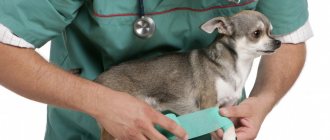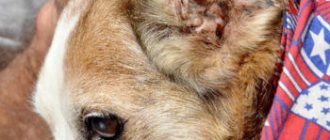In terms of devotion to its owner, no pet can compare with a dog. When caring for your pet, a person becomes so attached to it that in the event of health problems, he worries no less than for his loved one. Many owners are concerned about the question: why does their baby Chihuahua grunt.
Symptoms that appear in a completely healthy pet are especially alarming. In this article we will touch on the problem of why Chihuahuas grunt, and we will try to find out what causes this phenomenon and whether it is dangerous for the dog’s life.
Symptom: the dog is sneezing, what to do
If the dog got out from under a dusty bed or from a dark closet, then sneezing is a normal reaction to dust and cobwebs. If a baby inhales pollen from a flower or the owner’s perfume, he is 100% likely to cough. Animals have a similar reaction to tobacco smoke.
Some pets sneeze to encourage the owner to play or otherwise draw attention to themselves.
But if the dog is breathing poorly or sneezing for no reason, you should take a closer look at its nose. There may be something larger than sand stuck in your nostrils, such as a blade of grass or an insect. Objects are removed by endoscopy, and rinsing with water or anti-inflammatory drops (Divopride) is prescribed.
The main difference between the painful condition and a simple reflex is the presence of whitish or yellowish discharge on the nose. This condition can be caused by allergies, colds, polyps, oncology, hypothermia or helminthic infestation. Depending on the cause, there will be different symptoms.
Sneezes and snorts
Snorting is a sign that your pet is trying to clear his sinuses . If the lobe is clean and there is no discharge, then the cause lies in a foreign object. In this case, a prolonged act of sneezing and other symptoms are noted:
- Anxiety (the dog rubs its nose with its paws);
- Difficulty breathing (the dog cannot draw in air and snorts);
- Coughing attacks are possible when the posterior connective tissue is blocked.
If your dog is sneezing heavily for several days, there is a reason to see a veterinarian. A single or double sneeze should not cause panic among owners.
The veterinarian will surgically remove the object. After which antiseptics (Anadin) and a course of antibiotics (Polydex) will be prescribed. It is important to show your pet to a doctor after treatment to conduct a final rhinoscopy to confirm the fact of recovery.
Another problem that causes a similar reaction is severe bruising. In this case, pain will occur when you press the spout. Injury can be caused by a sharp branch, a cat, or even a bee sting.
All cuts, injections or bruises of the lobe are very painful, because important receptors are located on the tailed nose. The owner can treat the edges with a solution of sodium permanganate or brilliant green, and seal it with a band-aid there so as not to close the nostrils.
Sneezes and coughs
Sneezing and coughing attacks in dogs look frightening, as if the animal is choking, convulsively gasping for air, and jerking its head. For an unprepared owner, such a picture will cause horror and panic, but there is no need to worry. Most likely, the pet has caught a cold.
His only symptom may be occasional sneezing or frequent coughing. But sometimes the disease takes on a different form:
- Heat;
- Chills;
- Lack of appetite;
- Lethargy.
In this case, the owner can independently cope with the problem:
- With children's "Pinosol", drop 1-2 drops into each nostril 3 times a day.
- When crusts appear, hydrogen peroxide diluted with water is dripped (1-2 drops each).
- Cough is treated with Pertussin children's syrup (no more than 1-2 teaspoons per day), Glyceram or Mucaltin.
If the cold is caused by hypothermia, then you need to take care of the warmth of the room in which the pet is located. It is better to put the heating pad in the sunbed for a while. From now on, you need to dress your dog in protective warm overalls and boots. There should be no drafts or temperature changes in the house due to air conditioning.
Why does the dog grunt?
The main feature of the Chihuahua breed that is important to know about is its very short and pointed muzzle. Because of this structure, the dog has “reverse breathing” - an irritated palate provokes a spasm of the pharynx. This syndrome is also called “reverse sneezing.”
Many owners are seriously frightened by such manifestations of their pets - the animal can suddenly strongly stretch its neck, tense its chest muscles, and strongly arch its back. At the same time, the Chihuahua convulsively gasps for air, wheezes and makes loud grunting sounds, as if he is suffocating.
The dog often (constantly) sneezes - what is the reason?
Why a dog sneezes a lot and often is a complex question. Sometimes the “foreign object” is a cancerous tumor or benign polyps. In this case, removal of damaged tissue, chemotherapy and recovery are required. Without rhinoscopy and tests, it is impossible to identify the cause of regular sneezing.
Chronic runny nose can cause systematic hypothermia. For example, if the dog is kept in a kennel or enclosure and does not have warm bedding or heating.
Sometimes sneezing is a breed trait. Yorkshire terriers, for example, can sneeze “in the nose,” that is, in the opposite direction. Other dogs with a short, straight muzzle are also prone to this reflex.
The dog has snot (runny nose) and is sneezing - how to treat it
If your dog is sneezing and sniffling, it most likely has allergies . In this case, other symptoms may appear: itching, swelling of the pharynx, discharge from the ears, increased lacrimation or salivation, in especially severe cases - anaphylactic shock, epilepsy.
To treat an allergic reaction, you must first find out the cause of its occurrence and identify the irritant. Most often, dogs suffer from food allergies, then it is worth removing chicken, wheat, corn from the diet or changing dry food to grain-free holistic food. If the irritation is caused by pollen, it is enough to limit your pet’s access to flowers. To speed up the healing process, antihistamines are prescribed.
Tracheal collapse in Chihuahuas, causes, symptoms, treatment
Tracheal collapse is considered the most common disease in Chihuahuas. Its symptoms include shortness of breath, cough and respiratory failure. Tracheal collapse is the process of deformation of the trachea, causing difficulty in the passage of air during exhalation and inhalation.
Typically, tracheal collapse is treated with anti-inflammatory drugs, chondroprotective and antitussive drugs, since during collapse the main task is to eliminate the cough. If your dog is suffering from severe tracheal collapse, surgical treatment may be an option.
Tracheal collapse in a Chihuahua
Dogs have proven themselves to be excellent pets.
Smart, loyal, sociable, excellent companions and protectors, devoted friends for single people and married couples. There is a wide variety of breeds to choose from on the market. Everyone will choose a four-legged friend based on their own preferences. Some consider the dog's watchdog qualities and menacing appearance, others consider its small size and friendly attitude towards adults and small children.
Due to the fact that most people live in urban environments and live in small apartments in multi-storey buildings, decorative dog breeds such as Spitz, Pugs, Chinese Crested and, of course, our favorite – Chihuahua, are popular today. They fit perfectly into the interior of the apartment, do not take up much space, and get along well with people and animals.
Unscrupulous breeders and breeders deliberately abuse breed standards and work to breed the most miniature offspring, practically tame. The result of their work are the so-called mini Chihuahuas, which, in fact, are a breed defect (defect), but for an impressive amount of money, in most cases exceeding the cost of standard representatives of the breed.
The buyer often does not realize that when buying a dwarf dog breed, in the future he may encounter the manifestation of a serious respiratory illness known as tracheal collapse. Chihuahuas are in the top three for respiratory disease.
What kind of disease is this, does it pose a threat to the health and life of the pet, how to deal with it? – we’ll talk. But first, let's dive into the school biology course, study the basic principles of the structure of the trachea, its purpose. This will help to understand the seriousness of the consequences of the development of tracheal collapse in a Chihuahua.
Dog sneezes blood
Blood signals a violation of the integrity of the capillaries. Either a foreign object damaged the skin, or the blood vessels burst from pressure due to overheating. If the bleeding does not stop, the pet should be seated with its head pointing down. The carrier is packed with cold (ice, a bottle of water, frozen semi-finished foods). After this, the pet must be taken to the veterinarian.
Another possible cause is chemical vapor poisoning . This often happens when a dog finds rat poison and tries to sniff it. Or at home he comes across detergents. In this case, the owner must urgently show the dog to a doctor.
Sometimes blood appears when sneezing due to prolonged rhinitis.
Main reasons
When dogs grunt, they try to clear their airways. There are many reasons why this can happen - the reins are too tight, strong odors, powder getting into the nose.
It happens that a pet sneezes when it is very happy or eats food faster than usual. Another reason is problems with the sky. Your pet may have a cleft or a soft or drooping palate.
There are more serious reasons - for example, serious health problems . It could be a tick, various infections, polyps in the mouth. Therefore, if your pet grunts with enviable regularity, then you should definitely show it to the veterinarian. Without timely assistance, the dog may get worse.
A heart attack is the most dangerous cause of grunting. The first thing that is important to pay attention to is the language. If he turns blue, the dog should be taken to the vet immediately.
Another problem that can cause a baby to “grunt” is obesity, so you need to monitor your Chihuahua’s diet and prevent the dog from overeating.
This problem is discussed in many veterinary forums. Doctors recommend carefully monitoring your pet’s condition, because dogs cannot talk about what’s bothering them. Therefore, all hope lies in the owner, who will sound the alarm in time, will not let the situation take its course, and will show the Chihuahua to a specialist.
Read here what foods you can feed your Chihuahua.
It is not always possible to independently diagnose the cause of grunting, so it is better to entrust the examination to a professional.
NOTE!
As veterinarians note, a dog that frequently grunts may have an inflammatory process, severe allergies, or collapse of the trachea.
Diagnostics
The veterinarian asks the owner about the dog’s condition and examines it. The owner must characterize the cough, name the date of its occurrence, and the conditions that accompanied its development. The doctor also asks about age, vaccinations, existing pathologies and living conditions. For diagnosis, the specialist uses:
- Bacteriological and cytological examination of sputum.
- Bronchoscopy.
- X-ray.
- ECG.
Entry of a foreign object into the respiratory tract
When a pet swallows something or chokes, it independently coughs up the foreign body. This is accompanied by a sudden and sharp reaction, taking an appropriate posture, and movements of the head and neck. When your pet has swallowed an object or sharp bone that is too large to pass through the digestive tract, the signs will be:
- The cough becomes prolonged, debilitating and attack-like.
- The animal seems to be trying to push a foreign object out of itself.
- Foam or blood is observed.
- Foam appears from the nostrils.
- Reluctance to drink and eat.
- Breathing becomes difficult.
- There is wheezing.
It is unacceptable to assume that the animal can handle it on its own: in order to pull out or at least see a stuck object, you need tools that only a specialist has. The dog is urgently taken to the hospital, because if you hesitate, inflammation, emphysema or complications quickly develop in the pleura, lungs and bronchi.
Living together in an enclosure
It also causes enclosure cough, which indicates infection with the virus due to contact or cohabitation of several individuals in the same enclosure. Everyone is infected by a large or newly recovered dog. Symptoms depend on the state of immunity and the characteristics of the pathogen (canine herpes, parainfluenza or bordetella). After an incubation period, which usually lasts 10 days, kennel cough appears along with:
- Severe attacks, as if the pet was choking on something.
- Increasing temperature.
- Enlarged lymph nodes.
- Discharge from the nostrils.
- Tearing.
- White foam.
The cough, which arose due to enclosure living and infection in the nursery, lasts about half a month. An animal with a strong immune system tolerates this condition more easily: sometimes, for the infection to go away, it does not need to be treated. A severe case requires a doctor to prescribe:
- Immunomodulatory drugs.
- Antibacterial.
- Antiviral.
- Expectorants.
Diagnosis and causes
The cough can be dry or wet; It is worth paying attention to productivity and duration, time of occurrence (sleep, physical activity), and the age of the pet. Are there other symptoms associated with it:
- weakness;
- sleep disturbance;
- temperature increase;
- refusal to eat;
- aggression;
- vomit;
- weight loss;
- mouth ulcers or bleeding;
- enlarged lymph nodes.
Important! If your pet coughs for a long time, additional symptoms appear - contact a specialist as soon as possible.
The causes of cough are usually:
- inflammatory processes of the respiratory system;
- throat diseases;
- tracheobronchitis;
- foreign objects caught in the respiratory tract;
- oral infections and dental diseases;
- heart diseases;
- tumor diseases of the lungs;
- parasite infection;
- allergic reaction;
- tracheal collapse.
Attention! Coughing is a physiological characteristic of brachycephalic (short-skull) breeds.
Sneezes and grunts
Grunting is a typical sound made by Mastiffs, Bulldogs and related breeds (even Pugs and Pekingese). The reason is the special structure of the muzzle and respiratory apparatus. But if grunting is accompanied by coughing, shortness of breath and sneezing, this is a reason to visit the veterinarian.
Such reflexes are the cause of helminthic infestation. Roundworms settle not only in the intestines, but also live throughout the body. If the pet is restless, often vomits, scratches the anal passage, while sneezing and grunting, then there is only one conclusion - infection with helminths. Routine cleaning should be carried out using the usual preparations.
A deadly pathology is tracheal collapse (softening of the cartilaginous rings of the trachea, blocking of the larynx, lowering the softening process to the bronchi). The disease is genetic and incurable.
Sneezing and coughing are not a reason to panic. If such attacks occur regularly, the owner knows what causes them and how to get rid of them, then there is no point in going to the clinic. But if the pathology is primary, then it is better to contact a veterinarian to find out the cause.
Symptoms of a collapsed trachea in a Chihuahua
The disease can be asymptomatic for a long time, which prevents timely diagnosis and provision of timely veterinary care to the suffering dog. In acute form it will lead to the death of the animal.
A characteristic and sure sign of tracheal collapse is “goose cackling” breathing, which is often compared to the grunting of a pig. It appears at rest and intensifies with excitement, excitement, during active exercise and games, eating and drinking. Chihuahua owners often confuse tracheal collapse with reverse sneezing syndrome because it sounds similar.
The owner should also pay attention to the following symptoms:
- stridorous (wheezing, noisy) breathing;
- obvious respiratory distress (shortness of breath, suffocation, heavy and rapid breathing, grunting);
- * sudden uncontrollable attacks of dry cough;
- rapid heartbeat at rest;
- bluish tint of the gums and oral mucosa;
- apathy and exercise intolerance;
- gagging while drinking and eating;
- cases of loss of consciousness.
* In a Chihuahua suffering from the disease, coughing often occurs when there is pressure on the neck, for example when pulling on a leash, or palpation (palpation) of the throat.
In some cases, the disease is accompanied by paralysis of the larynx, which may be evidenced by wheezing during breathing and hoarseness.
Symptoms of tracheal collapse in Chihuahuas can occur together or separately.
Cough does not always signal tracheal collapse. It can be called:
- adenovirus;
- allergic reaction to surrounding allergens;
- pulmonary hypertension;
- collapse of the main bronchi;
- entry of a foreign body into the respiratory tract;
- cardiac diseases;
- ARVI and a number of other factors.
Only a specialist with diagnostic equipment can determine whether the above symptoms are indeed a manifestation of a collapsed windpipe.










